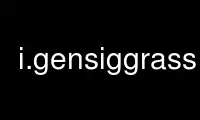
This is the command i.gensiggrass that can be run in the OnWorks free hosting provider using one of our multiple free online workstations such as Ubuntu Online, Fedora Online, Windows online emulator or MAC OS online emulator
PROGRAM:
NAME
i.gensig - Generates statistics for i.maxlik from raster map.
KEYWORDS
imagery, classification, supervised classification, Maximum Likelihood Classification,
MLC, signatures
SYNOPSIS
i.gensig
i.gensig --help
i.gensig trainingmap=name group=name subgroup=name signaturefile=name [--help]
[--verbose] [--quiet] [--ui]
Flags:
--help
Print usage summary
--verbose
Verbose module output
--quiet
Quiet module output
--ui
Force launching GUI dialog
Parameters:
trainingmap=name [required]
Ground truth training map
group=name [required]
Name of input imagery group
subgroup=name [required]
Name of input imagery subgroup
signaturefile=name [required]
Name for output file containing result signatures
DESCRIPTION
i.gensig is a non-interactive method for generating input into i.maxlik. It can be used
as the first pass in the GRASS two-pass classification process (instead of i.cluster or
g.gui.iclass). It reads a raster map layer, called the training map, which has some of
the pixels or regions already classified. i.gensig will then extract spectral signatures
from an image based on the classification of the pixels in the training map and make these
signatures available to i.maxlik.
The user would then execute the GRASS program i.maxlik to actually create the final
classified map.
OPTIONS
Parameters
trainingmap=name
ground truth training map
This map must be prepared by the user in advance using vector or raster digitizer. Of
course other methods could be devised by the user for creating this training map -
i.gensig makes no assumption about the origin of this map layer. It simply creates
signatures for the classes defined in the training map for the image to be classified (the
image is specified in other options - see below). The wxGUI vector digitizer can be used
for interactively creating the training map.
group=name
imagery group
This is the name of the group that contains the band files which comprise the image to be
analyzed. The i.group command is used to construct groups of raster layers which comprise
an image.
subgroup=name
subgroup containing image files
This names the subgroup within the group that selects a subset of the bands to be
analyzed. The i.group command is also used to prepare this subgroup. The subgroup
mechanism allows the user to select a subset of all the band files that form an image.
signaturefile=name
resultant signature file
This is the resultant signature file (containing the means and covariance matrices) for
each class in the training map that is associated with the band files in the subgroup
select (see above).
INTERACTIVE MODE
If none of the arguments are specified on the command line, i.gensig will interactively
prompt for the names of these maps and files.
It should be noted that interactive mode here only means interactive prompting for maps
and files. It does not mean visualization of the signatures that result from the process.
NOTES
The structure of the SIG files generated by i.gensig is as follows (ASCII file, used
internally by i.maxlik):
Note: the line numbers are not present in the file but have been added here for
explanation only:
SIG file "lsat7_2000_gensig":
1 #
2 #water
3 4186
4 67.9508 48.7346 37.8915 15.3129 13.8473 12.0855
5 1.74334
6 0.439504 2.07267
7 0.662523 1.63501 4.21189
8 0.530339 2.40757 5.52857 22.433
9 0.561184 2.30762 5.18846 20.5364 20.4926
10 0.393218 1.2184 2.63628 9.61528 9.36025 5.85314
· Line 2: text label
· Line 3: number of points in class
· Line 4: mean values per band of the class
· Line 5-10: (semi)-matrix of band-band covariance
Use i.gensiggrass online using onworks.net services
